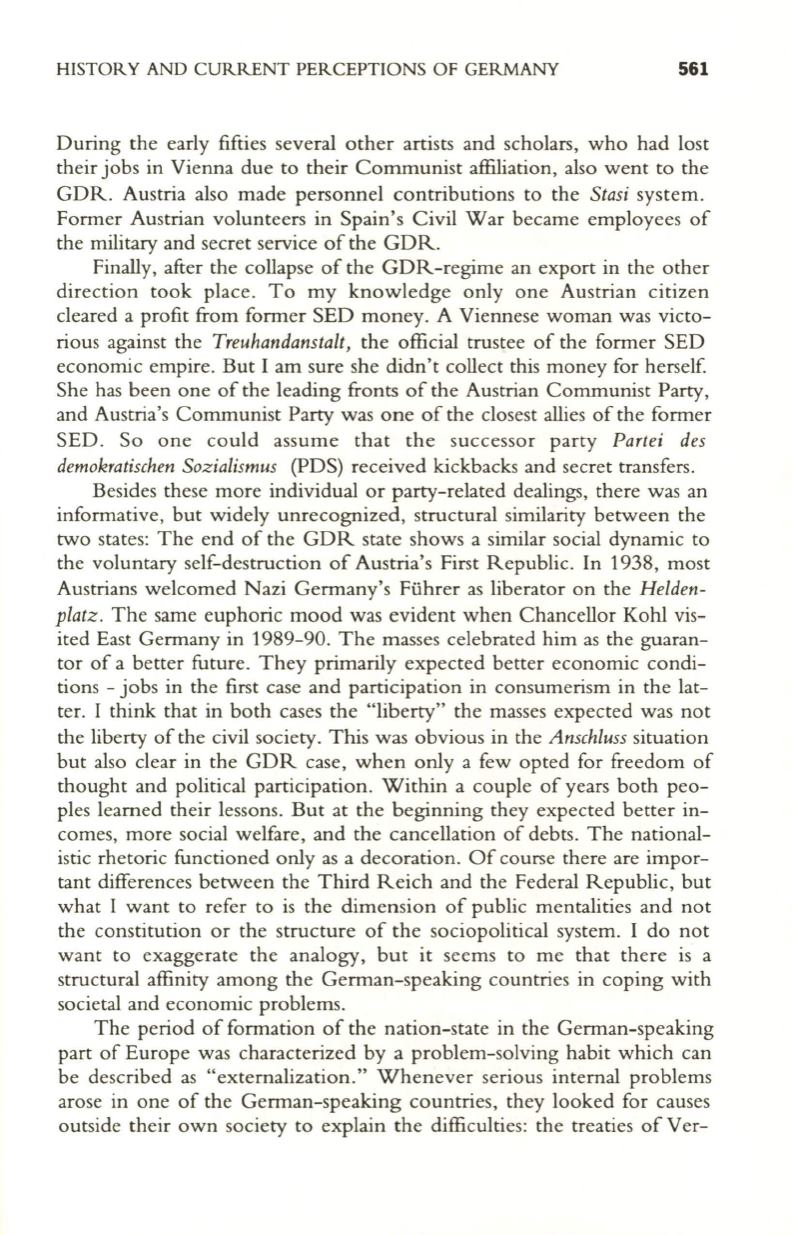
HISTORY AND CURRENT PERCEPTIONS OF GERMANY
561
During the early fifties several other artists and scholars, who had lost
their jobs in Vienna due to their Communist affiliation, also went to the
GDR. Austria also made personnel contributions to the
Stasi
system.
Former Austrian volunteers in Spain's Civil War became employees of
the military and secret service of the GDR.
Finally, after the collapse of the GDR-regime an export in the other
direction took place. To my knowledge only one Austrian citizen
cleared a profit from former SED money. A Viennese woman was victo–
rious against the
Treuhandanstalt,
the official trustee of the former SED
economic empire. But I am sure she didn't collect this money for herself
She has been one of the leading fronts of the Austrian Communist Party,
and Austria's Communist Party was one of the closest allies of the former
SED. So one could assume that the successor party
Partei des
demokratischen Sozialismus
(PDS) received kickbacks and secret transfers.
Besides these more individual or party-related dealings, there was an
informative, but widely unrecognized, structural similarity between the
two states: The end of the GDR state shows a similar social dynamic to
the voluntary self-destruction of Austria's First Republic. In 1938, most
Austrians welcomed Nazi Germany's Fuhrer as liberator on the
Helden–
platz.
The same euphoric mood was evident when Chancellor Kohl vis–
ited East Germany in 1989-90. The masses celebrated him as the guaran–
tor of a better future. They primarily expected better economic condi–
tions - jobs in the first case and participation in consumerism in the lat–
ter. I think that in both cases the "liberty" the masses expected was not
the liberty of the civil society. This was obvious in the
Anschluss
situation
but also clear in the GDR case, when only a few opted for freedom of
thought and political participation. Within a couple of years both peo–
ples learned their lessons. But at the beginning they expected better in–
comes, more social welfare, and the cancellation of debts. The national–
istic rhetoric functioned only as a decoration. Of course there are impor–
tant differences between the Third Reich and the Federal Republic, but
what I want to refer to is the dimension of public mentalities and not
the constitution or the structure of the sociopolitical system. I do not
want to exaggerate the analogy, but it seems to me that there is a
structural affinity among the German-speaking countries in coping with
societal and economic problems.
The period of formation of the nation-state in the German-speaking
part of Europe was characterized by a problem-solving habit which can
be described as "externalization." Whenever serious internal problems
arose in one of the German-speaking countries, they looked for causes
outside their own society to explain the difficulties: the treaties of Ver-


